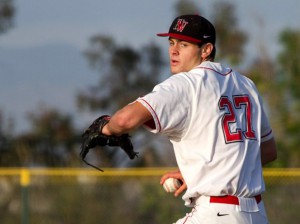
Giolito scheduled for TJ surgery, to the surprise of few apparently. Photo Eric Dearborn via win for teddy blog
Frequent readers of this blog have told me lately that i’m too pessimistic, that I’m “not having fun” with the team and its best record in baseball. Fair enough; its kind of difficult to write opinion pieces on a team in first place. But even given that, i’ve tried to write some more positive stuff lately.
However, beware; this is going to be another negative post. Because we just learned that our 2012 #1 draft pick Lucas Giolito needs to have Tommy John surgery after just TWO professional innings.
I made my point the day we drafted Giolito; you can read this June 5th post or read this executive summary; Giolito by himself wasn’t a bad risk, but combining him with Matthew Purke (on the DL all year) and Anthony Rendon (who has had significant injuries in 3 out of the last 4 seasons) puts all of this team’s proverbial eggs into one dangerous basket. I thought it was negligent to draft an injury risk, given the major injury risk drafted just the previous year in Purke and the ongoing injury issues of Rendon.
Make no mistake; the Nats essentially sacrificed most of this draft for the express purpose of freeing up enough money to sign Giolito out of his UCLA committment. Check out the known bonuses paid in the top 10 rounds; most of them were below-slot and a number of college seniors (with no leverage) were picked. Now, every team in the majors was also doing this (an unanticipated side effect of the new CBA draft rules that are not are good for the game, at all, as with most of the new CBA when it comes to amateur players), but the consensus in the industry was that the Nats essentially “punted” the 2012 draft in the hopes of signing Giolito.
Which would be great, if Giolito was healthy. But he wasn’t. Here’s a tidbit that I didn’t know: I listened to a Baseball Prospectus podcast two weeks ago and one of Kevin Goldstein‘s guests was none other than Lucas Giolito’s father. The conversation/intervew was great; Giolito talked about what it was like having a superstar baseball kid growing up, what it was like having a little leaguer who could throw 78mph as a 12yr old, and what it was like having a 16-yr old rising HS junior at the Area Code games. He also talked through their whole spring of 2012, from the injury to getting drafted to the decision to sign. All interesting stuff.
One tidbit I learned though, having not heard it anywhere else previously, was this: Lucas didn’t have a “sprained UCL” as was widely mentioned at the time. According to his father, he had a PARTIAL TEAR of the UCL, NOT a sprain. And the Nats drafted him anyway. Knowing this, is it ANY surprise whatsoever that the kid blows out the elbow 2 innings into his pro career?? Lets get this straight; a kid who throws 100mph has a partial tear of the main tendon that allows him to throw 100mph, and we think this tendon is just going to magically heal itself? A normal person may heal that tendon to the point where you can live your life and not be bothered. A professional pitcher, upon tearing that tendon, is always going to have a weakness that eventually will require surgical repair.
Lets face it; the Nats have had some good fortune with their pitchers having TJ surgery lately and coming back. Zimmermann and Strasburg examples 1A and 1B. Former top prospect Jack McGeary had it and is still in the low minors, struggling to regain his form, an example of a guy who didn’t exactly come back roses from the surgery. Taylor Jordan and Sammy Solis both had it earlier this year, one representing a promising underrated arm and the other representing a significant blow to the farm system depth, and they’ll be more test cases. And now we have Giolito.
I read another nats blog this morning who cheerily said something along the lines of, “Well, he’ll get the surgery and we’ll have a 20-yr old in 2014 who can throw 100mph.” That statement represents the absolutely 100% best case scenario here. Tommy John recoveries are pretty high percentage wise, but they’re not 100%. 18yr olds pitchers who get cut aren’t exactly 100% to return to their prior form either. He may never come back from this surgery, he may never regain his velocity.
Prospect development in baseball is already risky enough; a huge percentage of first rounders never even make the majors. But that being said … first rounders who DO make the majors are the core of the stars in this league (don’t believe me? Get a list of the 20 best pitchers and look at their draft position; more than half of the “Aces” in this league were first round picks). My point is (and was in June) that we should have drafted a safer guy, a known quantity, so that we actually have something to show for the 2012 draft in a few years time.



